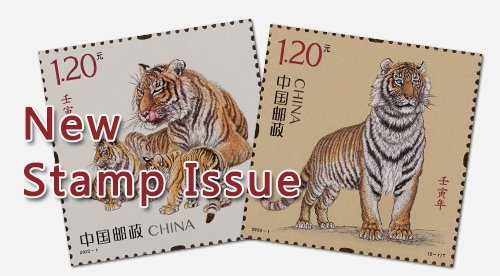 Postal Business: 8610 11185
Postal Business: 8610 11185Postal Savings: 8610 95580
Logistics and EMS: 8610 11183
China Post Life: 8610 4008909999
 National Day for Helping the Disabled...2018-12
National Day for Helping the Disabled...2018-12China Post issued a set of commemorative stamps all featuring the same design for the National Day for Helping the Disabled, with a denomination of 1.2 yuan (0.18 U.S. dollars), on May 20, 2018.
The fourteenth provision of the Law of the People's Republic of China on the Protection of Disabled Persons stipulates that the National Day for Helping the Disabled is marked on the third Sunday of May every year.
The national day aims to publicize the spirit of self-improvement for the disabled, to make the whole society better understand the living conditions of the disabled, to strengthen support for them, and create a more welcoming atmosphere and a social environment that is conducive to the sustainable development of the disabled.
May 20, 2018 marked the 28th National Day for Helping the Disabled with the theme of "None of the disabled will be left behind in completing the building of a moderately prosperous society in all aspects."
The stamps feature a stylized disabled person in white color in a wheelchair against the background of a giant heart, symbolizing the purity and beauty of the disabled and highlighting the theme that the whole society cares for the disabled.
Eight aids for the disabled are depicted in the background: barrier-free access, sign language, sign language, information, Braille, medical care, a wheelchair, service dog. It reflects the equal participation of the disabled in society and sharing in social development. The message behind the design is that the cause of the handicapped in China has witnessed vigorous development during the last forty years of reform and opening-up, especially since the China Disabled Persons' Federation (CDPF) was founded 30 years ago.
The set of stamps was designed by Shen Jiahong, and printed by Liaoning Post Printing Factory using an offset printing process.
 Silk Road Cultural Relics (I)...2018-11
Silk Road Cultural Relics (I)...2018-11China Post issued a set of four special stamps of Silk Road Cultural Relics (I), with a denomination of 4.8 yuan (0.7 U.S. dollars), on May 19, 2018.
The stamps feature the four representative cultural relics unearthed from northwest China's Shaanxi Province -- the starting point of the Silk Road, namely a gilded bronze silkworm of the Han Dynasty (206 B.C.-220 A.D.), a gilded bronze horse of the Han Dynasty, an agate cup mounted on a gold ox head of the Tang Dynasty (618 A.D. - 907 A.D.) and a blue-glazed plate of the Tang Dynasty.
The Silk Road was an ancient network of trade routes that connected the East and West. It was central to cultural interaction between them for centuries. The Silk Road refers to both the terrestrial and the maritime routes connecting Asia with the Middle East and southern Europe.
The Silk Road derives its name from the lucrative trade in silk carried out along it, beginning in the Han Dynasty. The Han Dynasty expanded the Central Asian section of the trade routes around 114 B.C. through the missions and explorations of the Chinese imperial envoy Zhang Qian.
The northern route started at Chang'an (now called Xi'an) , traveled northwest through Gansu Province, Xinjiang Uygur Autonomous region, Central Asia, Western Asia, and connected land passages of the Mediterranean countries.
Trade on the Silk Road played a significant role in the exchange and integration of Chinese and foreign cultures. It has enriched the cultural style of China.
The Silk Road cultural relics are a symbol of the prosperity and long history of the Silk Road.
China Post issued a set of four special stamps of the Silk Road and a souvenir sheet in 2012. To promote the spirit of the Silk Road, the group has now issued special stamps of Silk Road Cultural Relics (I).
The gilded bronze silkworm of the Han Dynasty was unearthed in the Qianchi River of Shaanxi Province in 1984, and is now part of the collections of the Shaanxi History Museum. The bronze silkworm has a total of nine abdominal segments with complete chest feet, abdominal feet and tail feet. It is lifting its head and producing silk. Such a refined and lifelike relic was found in China for the first time.
The gilded bronze horse of the Han Dynasty was unearthed in Xiwu township of Shaanxi Province in 1985, and is now housed in the Maoling Mausoleum Museum.
The bronze horse stands upright in a simple and elegant pose, glittering and solid. According to research, it was the ornamental mould of the Akhal-teke horses that were unearthed in the Imperial Forest Park of the Han Dynasty.
The agate cup mounted on a gold ox head of the Tang Dynasty was unearthed in Hejia village of Shaanxi Province, and is now housed in the Shaanxi History Museum.
It was carved from agate with mixed colors in red, brown and white. One end of the agate is carved into the mouth of a cup and the other is carved into a vivid ox head. The agate cup is of exquisite workmanship and has a glassy luster. It has important reference value for the study of cultural exchanges between China and foreign counties in the Tang Dynasty.
The blue-glazed plate of the Tang Dynasty was unearthed in the Famen underground palace of Shaanxi Province in 1987, and is housed in Famen Temple Museum now.
The plate is blue and semi-transparent. It is elaborately decorated and is divided into several layers from inside to outside. The center is a flower of eight petals, banana leaves, reflecting the communication between China and the Islamic countries in the Tang Dynasty.
The stamp patterns have cultural relics as the main elements, with camels along the Silk Road, portrait of bricks of the Han Dynasty and silk ribbons decorated with flower patterns of the Tang Dynasty as the background.
The camel teams heading westward and eastward symbolize the cultural exchanges between the East and West, highlighting the concept of the Silk Road.
To highlight the texture of the cultural relics, all of the four stamps are printed using an embossing process, which makes them appear almost lifelike.
The background of the stamps is printed in pearlescent ink to highlight the theme of the Silk Road. This set of stamps was designed by Chen Jingyi, and printed by Henan Post Printing Factory using the offset printing process.
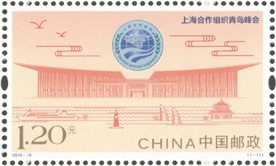 Shanghai Cooperation Organization Qingda...2018-16
Shanghai Cooperation Organization Qingda...2018-16China Post was scheduled to issue the commemorative stamp of the Shanghai Cooperation Organization (SCO) Qingdao Summit, with a denomination of 1.2 yuan (0.187 U.S. dollars), on June 9, 2018.
The SCO, founded in 1996 as a group known as the Shanghai Five, is a loosely configured economic and military alliance between the People's Republic of China, the Russian Federation, the Kyrgyz Republic, and the republics of Tajikistan, Kazakhstan, and Uzbekistan. India and Pakistan joined the SCO as full members on June 9, 2017 at a summit in Astana, Kazakhstan.
The SCO has four observer states, namely the Islamic Republic of Afghanistan, the Republic of Belarus, the Islamic Republic of Iran, and the Republic of Mongolia.
It has six dialogue partners, namely the Republic of Azerbaijan, the Republic of Armenia, the Kingdom of Cambodia, the Federal Democratic Republic of Nepal, the Republic of Turkey, and the Democratic Socialist Republic of Sri Lanka.
The SCO's main goals are as follows: strengthening mutual trust and neighborliness among the member states; promoting their effective cooperation in politics, trade, the economy, research, technology and culture, as well as in education, energy, transport, tourism, environmental protection, and other areas; making joint efforts to maintain and ensure peace, security and stability in the region; and moving towards the establishment of a democratic, fair and rational new international political and economic order.
Proceeding from the Shanghai Spirit, the SCO pursues its internal policy based on the principles of mutual trust, mutual benefit, equality, mutual consultations, respect for cultural diversity, and a desire for common development, while its external policy is conducted in accordance with the principles of non-alignment, non-targeting of any third country, and openness.
The Heads of States Council (HSC) is the supreme decision-making body in the SCO. It meets once a year and adopts decisions and guidelines on all important matters of the organization. The SCO's official languages are Russian and Chinese.
The 18th SCO Summit, which was the 18th conference of the HSC, was scheduled from June 9 to 10 in Qingdao, east China's Shandong Province. China Post issued a set of one commemorative stamp of the SCO Qingdao Summit.
The stamp depicts the SCO emblem and the SCO Qingdao Summit Media Center which is the main stadium of the summit, and is decorated with propitious clouds and seagulls.
At the bottom of the frame are depicted a trestle bridge, sailboat, lighthouse and ship, displaying the characteristics of Qingdao.
This set of stamps was designed by Yu Qiuyan and Xing Wenwei, and printed by the Beijing Stamp Printing House using the heliographic printing process for Layout I and offset printing process for Layout II.
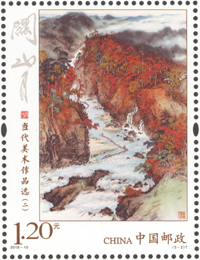 Collection of Contemporary Art Works (II...2018-10
Collection of Contemporary Art Works (II...2018-10China Post will issue a set of three special stamps featuring a collection of contemporary art works (II).
The stamps feature Looking up at High Mountains by Feng Zikai, A Raft Floating in a Stream by Guan Shanyue, and Majestic Mountains and Rivers by Li Kuchan.
With a denomination of 3.9 yuan (0.609 U.S. dollars), this is the second set of stamps issued after the collection of contemporary art works (I) in 1989.
Feng Zikai (1898-1975), born in east China's Zhejiang Province, was taught by Hong Yi, a Chinese Buddhist monk and artist.
Feng created cartoons and essays combining the styles of Chinese and Western paintings.
Among Feng's numerous creations, his most famous works include the short essay collection Yuan-Yuan Tang Sui Bi and the cartoon collection Zikai Cartoons.
The title Looking up at High Mountains is inspired by the Analects of Confucius, which means that the more you look up at the mountains, the higher you feel they are. It expresses an admiration for people or things.
The painting is simple and bright, with a long artistic conception.
The figures are vivid although they are shown from the back or side.
Guan Shanyue (1912-2000), born in south China's Guangdong Province, was a well-known painter, educator and representative of the Lingnan School of painting.
His representative works include The Land Is So Rich and Beautiful, which he created together with Fu Baoshi.
His publications include Guan Shanyue Album, Sketchbooks of Fu Baoshi and Guan Shanyue in Northeast China, as well as A Selection from Guan Shanyue’s Works.
The painting A Raft Floating in A Stream has strong colors and a meticulous delineation, creating a mighty visual impact.
It depicts the magnificence and beauty of the rivers and mountains of the countryside by combining the traditional painting techniques of Chinese and Western paintings.
Li Kuchan (1899-1983), born in east China's Shandong Province, was taught by the traditional Chinese painting master Qi Baishi.
Li was a famous freehand flower-and-bird painter, calligrapher and art educator.
He was skilled at drawing flowers and birds, for example hawks. His representative works feature lotuses, hawks, waterfowls, etc.
The painting Majestic Mountains and Rivers depicts two fierce eagles perching on a towering cliff. The eagles, with their talons clawing the cliff, are looking into the distance, expressing Li's spirit of supporting justice.
Designed by Shi Yuan, this set of three stamps is printed by the Beijing Stamp Printing House in woodblock overprinting, offset printing and heliographic printing respectively.
This is the second set after A Selection from Liu Haisu's Works, which were printed using a different printing process.
 200th Anniversary of the Birth of Karl M...2018-9
200th Anniversary of the Birth of Karl M...2018-9China Post will issue a set of two commemorative stamps to mark the 200thanniversary of the birth of Karl Marx in 1818.
The set of stamps depicts Marx and Friedrich Engels, with a denomination of 2.4 yuan (0.37 U.S. dollars).
Marx (1818-1883) was one of the founders of Marxism, a great teacher and spiritual leader of the proletariat and the working people all over the world, and the pioneer of the contemporary communist movement.
His famous philosophical theory is historical materialism. Marx created scientific socialism with Engels, which is a theoretical weapon and a guide in the fight of the working people around the world to achieve the great ideals of socialism and communism.
Marx wrote many articles and works of great significance throughout his life. The most famous are The Communist Manifesto and the three-volume Das Kapital.
The Communist Manifesto is the first programmatic document of scientific socialism. Das Kapital, guided by the basic thought of historical materialism, reveals the law of the development of capitalist society through a profound analysis of the capitalist mode of production, which confirms historical materialism and realizes further development.
The designer of the stamps is Wu Weishan, curator of the National Art Museum of China and vice-chairperson of the China Artists Association.
As a famous sculptor in China, Wu’s most representative sculptures include “Confucius,”“Conversation between Qi Baishi and Leonardo Da Vinci,” and “Asking the Way.”
The set of stamps is a selection of Wu's classic sculptures. The first stamp shows Marx with his former residence in Trier, Germany as the background. The second shows Marx and Engels, with the German and Chinese versions of The Communist Manifesto and the Chinese version of Das Kapital as the background.
The stamps were printed by the Beijing Stamp Printing House using the heliographic printing process.
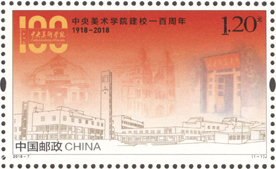 100th Anniversary of the Founding of CAF...2018-7
100th Anniversary of the Founding of CAF...2018-7Located in Beijing, the Central Academy of Fine Arts (CAFA), the only art academy of higher learning directly under the Ministry of Education, was founded in April 1950 by incorporating the National Beiping Art College and the Fine Arts Department of Huabei University. Chairman Mao Zedong inscribed the name for the Academy. The National Beiping Art College could trace its roots back to the National Beijing Art College, the first national art education institution in Chinese history as well as the beginning of modern art education in China, which was founded in 1918 under the initiative of the well-known educationist Cai Yuanpei.
CAFA's main objectives are the cultivation of high-quality professionals who are members of the elite in the arts. CAFA retains a reasonable scale in terms of space and student number, highlighting its academic, experimental, practicing and multi-disciplinary developments, which are suitable for an educational institution for the finer arts today.
CAFA is an academy where culture, history and art flourish. It enjoys the best art resources in the world. CAFA, as a leading institution for modern art education in China, provides the perfect environment for those who wish to gain experience and engage in creative work, and has nurtured quite a lot of famous artists in the past ninety years.
Under the umbrella of CAFA, there are eight schools and colleges. They are the School of Fine Art, School of Chinese Painting, School of Design, School of Architecture, School of Humanities, College of City Design as well as School of Continuing Education and the Affiliated High School of Fine Art. CAFA offers first-rate libraries and studios for its students and teachers.
 China's Literary Classics - Dream of the...2018-8
China's Literary Classics - Dream of the...2018-8Dream of the Red Chamber, also called Story of the Stone, is a couplet novel composed by Cao Xueqin.
Based on the four wealthy aristocratic Jia, Shi, Wang and Xue clans, this novel explores the tragic love story between Jia Baoyu, the carefree adolescent male heir of the family, and his sickly cousin Lin Daiyu. It covers the episodic rise and decline of the two branches of the Jia clan - the Rongguo and Ningguo houses, who reside in two large, adjacent family compounds in the capital.
The plot covers a variety of subject areas, such as poetry, ditties, odes, songs, music, chess, calligraphy, painting and other traditional forms of culture. With fine and vivid language, the novel has created many memorable characters and is a remarkable artistic achievement.
The third issue of this set of stamps depicts the scenes in chapters 41, 42, 44 and 45 of the novel. The souvenir sheet depicts those in chapter 37.
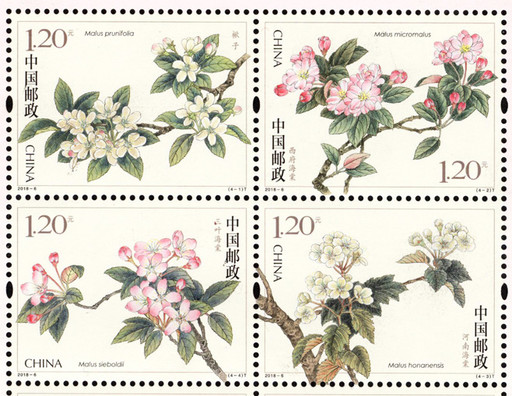 Malus Spectabilis2018-6
Malus Spectabilis2018-6This set of stamps depicts the crabapple species malus micromalus, malus honanensis, malus prunifolia and malus sieboldii.
Malus micromalus, or the midget crabapple, was Premier Zhou Enlai's favorite fruit tree.
What is the most significant is that 2018 marks the 120th anniversary of the birth of Comrade Zhou Enlai in 1898.
The set of stamps was issued to commemorate the great man.
Featuring traditional Chinese painting techniques, the stamps depict the exquisite twigs of the fruit trees.
The blossoms, buds, petals, stalks and leaves are depicted in a realistic fashion.
The off-white background highlights the elegant style of malus spectabilis.
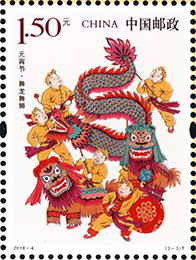 Lantern Festival2018-4
Lantern Festival2018-4As one of China's traditional festivals, the Lantern Festival or the Spring Festival is a festival celebrated on the fifteenth day of the first month in the lunar calendar.
Some legends associate the Lantern Festival with the ancient idea of climate, Taoism, and Buddhism.
It indicates that people worshipped the moon in ancient times for they welcomed the first full moon of the lunar new year on that night.
To celebrate the festival, people use lanterns as decorations and spend the occasion joyfully.
It also marks the final day of the traditional Chinese New Year celebrations.
 The 13th National People's Congress...2018-5
The 13th National People's Congress...2018-5The first session of the 13th National People's Congress (NPC) commenced in Beijing on March 5, 2018.
It is a grand conference to fully implement President Xi Jinping's socialist ideology with Chinese characteristics in the new era and the spirit of the 19th Communist Party of China (CPC) National Congress.
It is of great significance to unify the thought and action of the whole Party and the peoples of all ethnic groups through the spirit of the 19th CPC National Congress and through the major objectives and tasks it established.
- 最前 上一页 1 2 3 4 5 下一页 最后
 Register number: 京ICP备15035540号 京公网安备110401400185号
Register number: 京ICP备15035540号 京公网安备110401400185号 Powered by CHINA POST | About Us | Sitemap | Contact Us |



